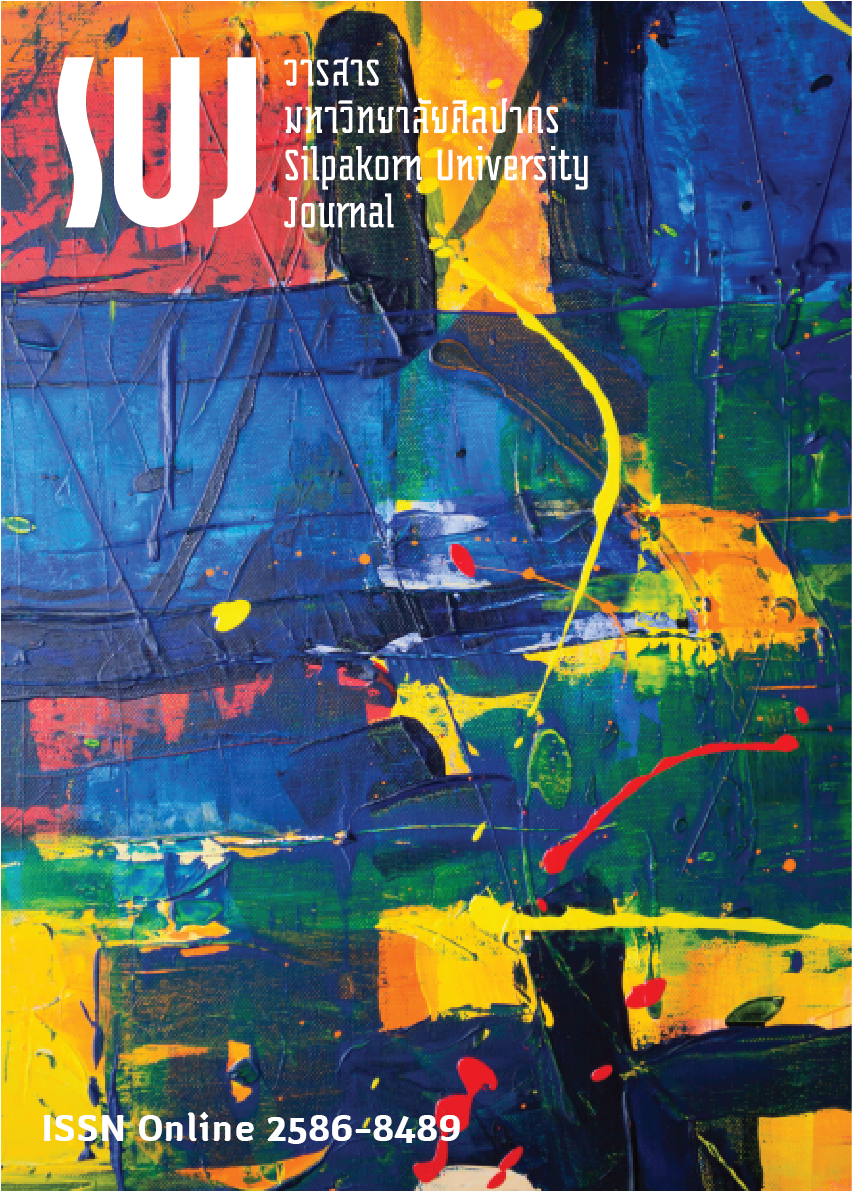จิตรกรรม : ความงามในจริยวิถีพอเพียง (Painting : Beauties in ethical and sufficient way)
Main Article Content
Abstract
งานวิจัยเรื่อง “จิตรกรรม: ความงามในจริยวิถีพอเพียง” มีวัตถุประสงค์ 1) เพื่อสร้างสรรค์ผลงานจิตรกรรมให้มีอารมณ์ความรู้สึกตามที่ได้ศึกษาแก่นเรื่องที่กำหนดไว้ ได้แก่ “ความงามในจริยวิถีพอเพียง” 2) เพื่อนำเสนอผลงานจิตรกรรมที่สร้างสรรค์ขึ้นสู่สาธารณชนด้วยรูปแบบนิทรรศการในหอศิลป์ที่มีคุณภาพมาตรฐาน และ 3) เพื่อศึกษาความคิดเห็นของประชากรตัวอย่างเกี่ยวกับสุนทรียะที่ได้รับจากการชมนิทรรศการ
ผลการวิจัยพบว่า การสร้างสรรค์ผลงานทั้ง 5 ชิ้นได้รับแรงบันดาลใจจากประสบการณ์ตรงในช่วงวัยเด็กของผู้วิจัยและการศึกษาค้นคว้าข้อมูลที่เกี่ยวข้อง จากนั้นจึงร่างภาพความคิด โดยวางขอบเขตย่อยของแต่ละชิ้นงานไว้อย่างหลวมๆ มุ่งเน้นการแสดงออกทางรูปแบบรูปลักษณ์ ใช้รูปทรงสัญลักษณ์ของพืชผลของผักสวนครัว ผลไม้ พืชพันธุ์ สัตว์เลี้ยงและส่วนประกอบอื่น ๆ ที่เกี่ยวข้อง มาผสานรวมกันด้วยวิธีการจัดองค์ประกอบศิลป์ โดยใช้หลักการดุลยภาพแบบอสมมาตร วางกลุ่มรูปทรงประธานจัดวางไว้ในส่วนกลางหรือส่วนล่างของภาพด้วยการใช้สีให้เกิดมิติที่ชัดเจนกว่ากลุ่มรูปทรงรอง และวางพื้นที่ว่างเพื่อแสดงทัศนียภาพเชิงบรรยากาศ ผลงานสร้างสรรค์ทั้งหมดมุ่งแสดงอารมณ์ความรู้สึกที่งดงามอุดมสมบูรณ์จากสัญลักษณ์ที่มีความสัมพันธ์กัน สะท้อนวิถีชีวิตประจำวันของมนุษย์ที่ยึดหลักการดำเนินชีวิตแบบพอเพียง แสดงความผูกพันที่ลึกซึ้งระหว่างมนุษย์กับธรรมชาติ และให้ความรู้สึกสุขสงบและปลอดภัย จากนั้นผู้วิจัยนำเสนอผลงานที่สร้างสรรค์ขึ้นสู่สาธารณชนในรูปแบบนิทรรศการ ผ่านกระบวนการออกแบบวางแผนผังห้องนิทรรศการ การจัดระยะการมองเห็นภาพผลงานจิตรกรรม และการจัดไฟเพื่อให้แสงสว่างที่เหมาะสม ผู้วิจัยสรุปผลศึกษาสุนทรียภาพของผู้ชมนิทรรศการจากผลการวิเคราะห์ข้อมูลจากแบบสอบถามความคิดเห็นทางสุนทรียะที่มีต่อผลงาน “จิตรกรรม: ความงามในจริยวิถีพอเพียง” จากกลุ่มตัวอย่าง 200 คน พบว่ามีค่าร้อยละสูงที่สุดทั้งหมด 8 ประเด็น ได้แก่ 1) ผลงาน “จิตรกรรม: ความงามในจริยวิถีพอเพียง” ชิ้นที่ 5 มีความหมายตรงกับแก่นเรื่องมากที่สุด 2) มีความพึงพอใจในผลงานเท่ากันทั้งรูปทรงและเนื้อหา 3) มีความคิดถึงอดีต คิดถึงคนในครอบครัว 4) รู้สึกได้ถึงการใช้ชีวิตแบบพอเพียง 5) สิ่งที่ทำให้เกิดประกายความคิดของการใช้ชีวิตแบบพอเพียง คือ ผลิตผลพืชผักสวนครัว 6) เกิดแรงบันดาลใจอยากใช้ชีวิตแบบพอเพียง 7) จิตรกรรมในนิทรรศการชุดนี้ให้ประโยชน์ต่อการปรับอารมณ์และทัศนคติทางบวกของคนที่มีความทุกข์จากปัญหาชีวิตได้ และ 8) อยากให้ผู้วิจัยสร้างสรรค์งานในลักษณะนี้ต่อไป
The purpose of research project “Painting: Ethical and Sufficient Beauty” is to 1) create paintings which express harmonious emotion and feeling on the research theme of Ethical and Sufficient Beauty; 2) display the creative paintings and artwork exhibition to the public in a standard and qualified art gallery; and 3) examine the opinions of sample about beauty and their impression of the exhibition. The results of this project directly revealed that the researcher’s childhood experience and the study of related works became the inspiration for all 5 paintings. This childhood experience and related research information helped the researcher imagine and sketch ideas, idealistic images and scopes in mind before drawing, such as landscape pictures, sheds or rest areas, animal areas, stream areas and the combination of all these elements in the picture. Each picture is ordinarily viewed as a normal vision of lay person as same as the one towards the scenery paintings that appeared in the different atmosphere and time so that we have admired the visual elements: the different soft colors such as ones in the morning, in the evening and in twilight. The format, style and layout are all shown in these artworks using minimal symbols, such as kitchen garden fruits, vegetables, grains, seeds, pets and other relevant and harmonious elements in a primary setting of the pictures. Imagination and reality are naturally inseparable in art composition. Asymmetrical balance and harmony are evidently shown in these paintings. The principal elements of these paintings placed in the center or lower proportion are highlighted with brighter colors and more distinctive dimensions. Certainly, the other elements are undistinguished. Empty space is also used as atmospheric visual support. All creative paintings expose the richness of feelings and emotions that relate to the nature and daily life of human beings. The way of life based on the sufficient economy philosophy is deeply associated with the relationship between human and nature. This attachment causes calmness, happiness and safety in human life.
Finally, the researcher obtained the results of the aesthetic appreciation of 200 exhibition samples. The researcher’s academic knowledge assisted in this exhibition, so it became as complete as possible, such as the appropriate distance and the suitable lighting. The 8 core results of this study are briefly as follows: 1) satisfaction of paintings “Aesthetics in Ethical and Sufficient Lifestyle #5” 2) people’s equal satisfaction with the shapes and contents of the paintings, 3) participants reminisce about the previous times and members of their families, 4) participants realize the way of life based on the sufficient economy philosophy, 5) the kitchen garden products are the inspiration for the self-sufficient lifestyle, 6) the way of life based on the sufficient economy philosophy inspires the visitors in a desirable way, 7) the paintings in this exhibition help people who had problems by experiencing the positive emotion and attitude, 8) participants support the researcher’s project and other paintings of a similar theme in the future.
Article Details
References
Buddhadasa Bhikkhu. (2004). Buddhathatpiku : thesis on Buddhathatpiku about religion music poetry and art (สรรนิพนธ์พุทธทาสภิกขุว่าด้วยศาสนา ดนตรี กวี ศิลปะ). Bangkok: Sukkaphapjai Publication Co., Ltd.
Chakkaphak, Phansak. (2009). Beauty in Bloom. Bangkok: Bangkok Printing Co. Ltd.
Maksin, Kittipong. (2017). Kitipong Ti [Facebook]. [Online]. Retrieved August 15, 2017 from https://www.facebook.com/kitipong.ti
Nakhonsantiphap, Sanae. (2001). Wisdom Power : Collection of articles about humanity and social science (มนุษยศาสตร์ สังคมศาสตร์ : พลังปัญญา : รวมบทความด้านมนุษยศาสตร์และสังคมศาสตร์). Bangkok: Faculty of Humanities and Social Sciences, Bansomdejchaopraya Rajabhat University.
Pornrungrot, Charnarong. (2003). Art for Society (ศิลปะสู่สังคม). Bangkok: Faculty of Fine and Applied Arts, Chulalongkorn University.
Royal Academy. (1998). Art dictionary English-Thai (พจนานุกรมศัพท์ศิลปะอังกฤษ-ไทย). (2nd ed.). Bangkok: Khurusapha publisher (The Teachers’ Council of Thailand).
Suweerangkoon, Suthep. (2008). Social problems (ปัญหาสังคม). Bangkok: Odeon Store, Publication Co. Ltd.
Tangchalok, Ittipon. (2007). Teaching methods, approaches and creative guidance for advanced paintings (แนวทางการสอนและสร้างสรรค์จิตรกรรมขั้นสูง). Bangkok: Amarin Printing & Publication Co. Ltd.

